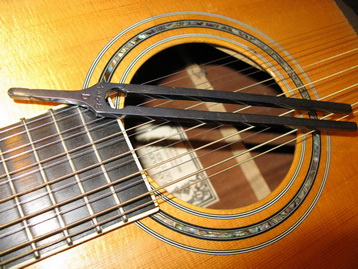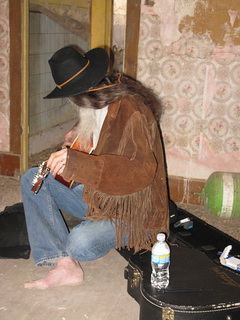The 12-string guitar is an amazing variation of the instrument. Whether acoustic or electric, the doubled strings add a unique, rich voice that you just can’t fake with a chorus box or harmonizer. Over the years it has been used in so many favorite and historic songs:

“Stairway to Heaven,” “A Hard Day’s Night,” “Jumpin’ Jack Flash,” “Turn! Turn! Turn!,” “Wish You Were Here” and many other instantly recognizable hits that just wouldn’t be the same without the 12-string.
The actual history of the 12-string is lost to the past. Some see the European influence of the “double course” instruments. These delicate instruments, like the lute, strung with double strings and crafted with such care by luthiers, lack the underbracing really required for standard tuning of a 12-string guitar.
Others see the influence of Spain and Mexico and their many variations of the guitar, braced and built with extra supports to carry the tremendous pull of doubling the strings.
How much tension is there on the strings of a 12 string guitar?
As an example, string maker D’Addario says that,
for a 6-string strung with an EXL110 set, these are the tensions when tuned to pitch:
- E .010 plain 16.2 lbs
- B .013 plain 15.4 lbs
- G .017 plain 16.6 lbs
- D .026 wound 18.4 lbs
- A .036 wound 19.5 lbs
- E .046 wound 17.5 lbs
That is over 100 pounds of pull for a set of “extra lights.”
Cumulative pounds of pull is one reason most people tune
the 12-string down a whole step.
Even tuned lower, a 12-string is pulling nearly 200 lbs of tension on the bridge.
Traditionally, the 12-string was used by solo performers, street musicians, troubadours, folks that needed extra volume. It is likely that the modern 12-string is a healthy mix of old-world style and third-world construction methods born of a need for volume.
Long before amps and P.A. Systems, guitar players the world over wanted the same thing we do: “more me in the mix.” Unable to turn a handmade six-string classical guitar up louder, some genius invented the 12-string. My kinda guy!

How to tune a 12-string guitar?
The short answer is; just like a 6-string. Actually, you treat the pairs as single strings when you play. The pairs are tuned in octaves except for the 1st and 2nd sets. These high pairs should be tuned in unison, or the higher-octave strings would break.
Unless you are using super-light strings I recommend tuning down a whole step to D. Tune the lower of the 6th string set (11th) to D below middle C and the higher string of the set an octave higher than that. (12str. Open = 11str. 12th fret.)
The lower strings of each set get tuned the same as your 6 string. The 1st and 2nd sets are tuned in unison. All the others are tuned an octave higher than its pair.
If you have a standard tuner it should allow you to tune down to D and still get readings. Just remember the notes are all a whole step lower. So instead of Every Body Gets Drunk At Ed’s or EBGDAE it should read DAFEGD or Dan Always Follows Ed Getting Drunk. (1st to 6th )
Alternate tunings like open chords and pairs in 5ths are for another article. Usually the pairs still get treated the same way, octaves except for the first two sets which are tuned in unison.
How to play a 12-string guitar?
Just like a 6-string. Treat the pairs as if they were one string. The richest, fullest sound from a 12-string is that of a big ol’ open chord. Therefore, it is often played using big, open string first position chords.
A capo on the second fret can be used to match it up with the rest of the band, but consider transposing the songs down a step and leaving the capo off. The rich, full sound of a 12-string makes it special. Adding the capo deadens the sound a little. To me, it is much more interesting to transpose the song, and the transposition adds the benefit that each guitar player will be playing entirely different chord forms that sound the same. If your song is in D, my big open E chord is what sounds when I play it. That is a classic 12-string chord: big, loud sound from a little chord.
I play the 12-string almost exclusively as a solo performer. It is really odd for me to hear my songs played on a 6-string. They sound a little hollow, a little empty. If you don’t have one, go down to a music store and try one. You may find it to be just the thing your song needs. Whether it is the sweet intro before the metal, or the only instrument in the song, a 12-string adds a big, distinctive dynamic sound that you just can’t fake.
I leave you with a link to a playlist of some of my 12-string songs on YouTube.
Enjoy!
Stay Tuned!
DanG
Photos by wakitu
Please share this.



